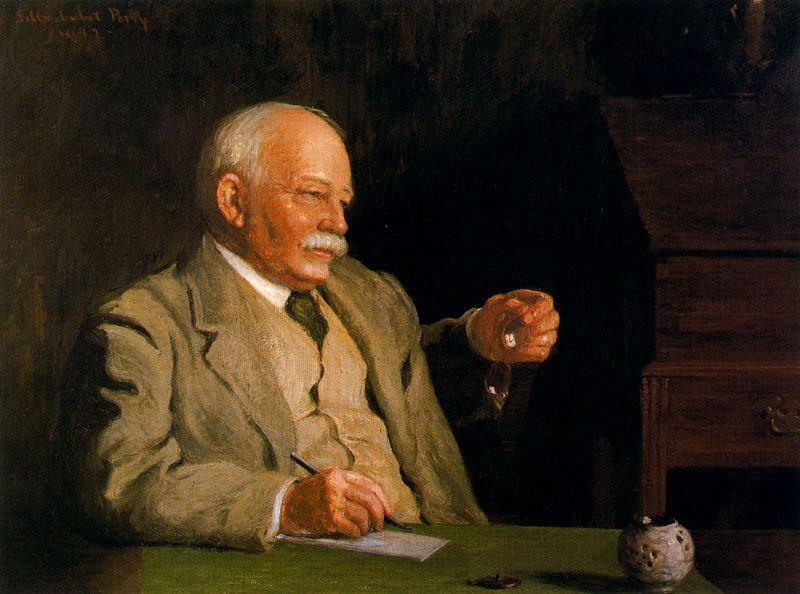
Lilla Cabot Perry, a prominent American impressionist painter, left an indelible mark on the art world with her vibrant and emotive works. Born on January 13, 1848, in Boston, Massachusetts, Perry’s journey from a privileged upbringing to a life dedicated to art is a testament to her passion, determination, and contribution to the evolution of American Impressionism.

Lilla Cabot Perry, born Lilla Cabot in a wealthy and cultured Boston family, experienced a childhood enriched with exposure to literature, music, and art. The Cabot family’s social standing provided young Lilla with the opportunity to engage with Boston’s intellectual elite. Her early years were marked by private tutors, European travels, and a nurturing environment that fostered her intellectual curiosity.

It was during her travels to Europe, particularly in Paris, that Perry’s artistic awakening took place. Inspired by the vibrant art scene and the revolutionary works of the Impressionists, she developed a keen interest in painting. Her exposure to the works of artists such as Claude Monet and Edgar Degas ignited a spark within her, compelling her to pursue art as more than just a pastime.

Upon returning to Boston, Lilla Cabot Perry began her formal art education at the Cowles Art School. Despite societal expectations for women at the time, Perry’s determination and passion for art led her to defy conventions and pursue a path that would become her life’s calling.
The Parisian Sojourn
In 1887, at the age of 39, Lilla Cabot Perry made a significant decision that would shape her artistic identity—she moved to Paris with her husband, Thomas Sergeant Perry, and their three daughters. This transformative period marked a pivotal chapter in Perry’s artistic journey, as she immersed herself in the thriving Parisian art scene and became a student of the renowned painter Alfred Sisley.

Under Sisley’s guidance, Perry embraced the techniques of Impressionism, characterized by the use of light, color, and capturing the essence of a moment. Her works began to reflect the influence of this innovative movement, showcasing a departure from traditional academic styles. Perry’s brushstrokes became bolder, and her palette more vibrant, as she captured scenes with a newfound freedom and spontaneity.

Perry’s time in Paris not only deepened her technical skills but also exposed her to a community of fellow artists, including Mary Cassatt and Berthe Morisot. These connections were instrumental in shaping Perry’s understanding of her own artistic voice and contributed to the broader dialogue of American artists abroad.
Family, Motherhood and Art
As a mother of three daughters, Perry faced the challenge of balancing her roles as a parent and an artist. She navigated the demanding expectations of motherhood during an era when women’s societal roles were predominantly defined by domesticity. Perry, however, approached this challenge with resilience and creativity, often incorporating her family life into her art.

Her paintings frequently depicted intimate scenes of domesticity, portraying her daughters engaged in everyday activities. Perry’s ability to capture the nuances of familial relationships and the tenderness of motherhood added a personal dimension to her work. Through her art, she challenged the conventional boundaries that constrained women in the late 19th and early 20th centuries.

Despite the challenges, Perry’s commitment to her craft remained unwavering. She found solace and inspiration in her family life, incorporating the beauty of motherhood into her canvases. This delicate balance between familial responsibilities and artistic pursuits became a defining theme in Perry’s body of work, showcasing the harmonious integration of her roles as a mother and an artist.
Lilla Cabot Perry’s legacy extends beyond her artistic contributions. Her pioneering spirit, marked by a determination to pursue her passion in the face of societal expectations, paved the way for future generations of female artists. Perry’s works are celebrated for their emotional depth, luminous colors, and the ability to convey a profound sense of atmosphere.

Throughout her career, Perry exhibited widely in both the United States and Europe, gaining recognition for her unique interpretation of Impressionism. Her paintings are now housed in esteemed institutions, including the Smithsonian American Art Museum, the Museum of Fine Arts, Boston, and the National Gallery of Art.

Lilla Cabot Perry’s journey from the drawing rooms of Boston to the vibrant streets of Paris reflects not only a personal evolution but also a transformative period in the history of American art. Her legacy endures as a testament to the power of artistic expression, the pursuit of passion, and the ability to challenge societal norms. Through her luminous canvases, Perry continues to inspire and resonate with art enthusiasts around the world, leaving an indelible mark on the rich tapestry of American Impressionism.




